I’m probably the only person that currently owns both a Ford and Toyota yet, cheers for Chevrolet to win on Sundays. Yes, it is odd. And, perhaps, I am odd. But, regardless, I’m not driving a Chevy. I am driving a Ford.
My new ride is a 2013 Mustang GT Base Coupe with a 6-speed manual in Red Candy Metallic Tinted Clearcoat and black cloth interior. The only factory options are the Brembo package and 3.73 gears.
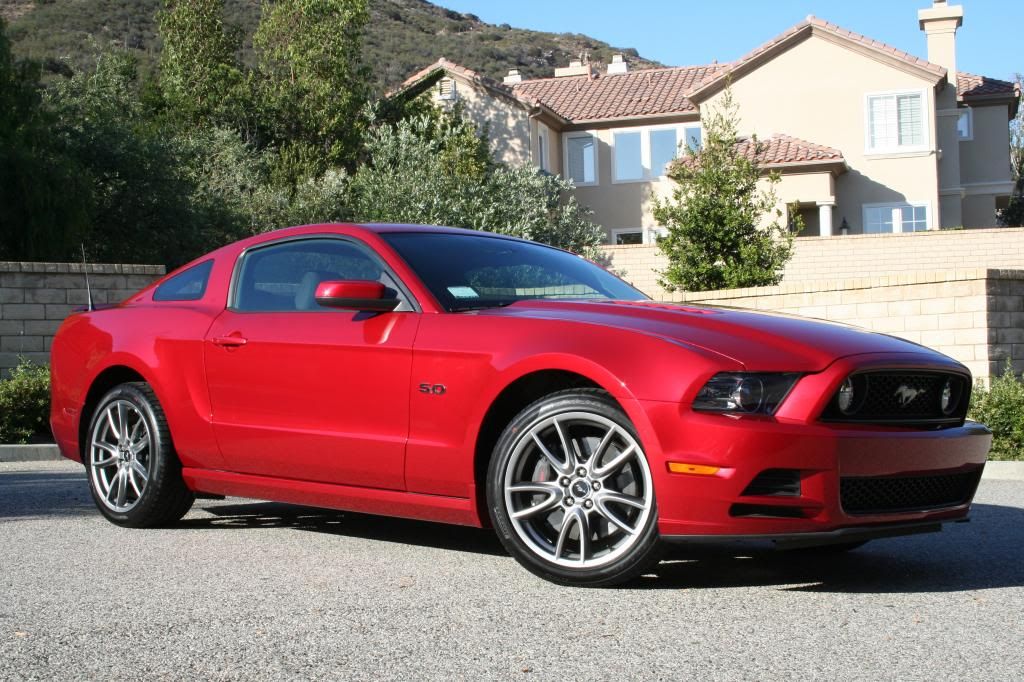
This is my fourth Mustang. I’ve previously owned an eye-catching 1966 289 Coupe, a perfect 1968 302 Coupe, and a super clean 1986 GT.
I must admit, it is great to be back driving a Mustang. And, it’s even more rewarding to once again, be driving a 5.0 V8 with a manual transmission.
The focus of this thread is to illustrate the path that I take to the upgrade, improve, and modify my new 2013 Mustang GT. I’ll include pictures and reviews of each modification I perform so that the information I share may benefit the community and perhaps help others in their quest to customize, or personalize their own Mustangs.
Let me begin.
I love cars. Over the years I’ve owned a ridiculous amount of cars of various makes and models both new and used. I enjoy the unique driving experience that each different type of car has to offer on and off the road. Due to my years of driving experience in so many cars, and the fact that I am an overly eccentric certified car enthusiast, I don’t hold any true brand loyalty to any manufacture. I simply try to buy the best car in the category I’m considering and at a price-range I can afford. This time around, it was the 2013 Ford Mustang GT. My new Mustang will serve as my regular daily-driver and weekend track-toy.
So why did I buy a new car? Ah, that’s easy. I missed driving a front engine, rear drive, 2+2 coupe with a V8, and a manual transmission. I love this combination of convenience, versatility, power, and fun. There are several cars that could serve my prescription but, even though the Challenger is a good looking car, my past has taught me not buy a Dodge product. You may be surprised but, even though I have a soft-spot for Chevy, each of new the Camaro SS’s I’ve driven over the past couple years left me thinking it feels big, bloated, heavy, and lazy. And it doesn’t stop there, the interior feels like you are sitting in a deep, bizarre, cheap, flimsy, Tupperware tub with strange futuristic cartoonish controls and poor outward visibility. The Chevrolet Camaro SS experience is frankly, disappointing and simply doesn’t measure up to the competition. As you can tell, I’m just not impressed with the new Camaro. Moreover the BMW M3 and Audi S5 are far too expensive and don’t have the raw performance I want, or expect from this type of platform. Furthermore, and most importantly, the European coupes just aren’t fun to drive.
In contrast, that wasn’t the way I felt after driving my first Coyote powered Mustang GT. The Mustang is comfortable, responsive, alive, and eager on the road. The Mustang is thoroughly enjoyable to drive. Plus, considering the competition, it is very affordable. In the end, you really can’t beat the value and performance of the Mustang GT. I was, and am, thoroughly impressed with the new Mustang. I know I’m going to enjoy this car.
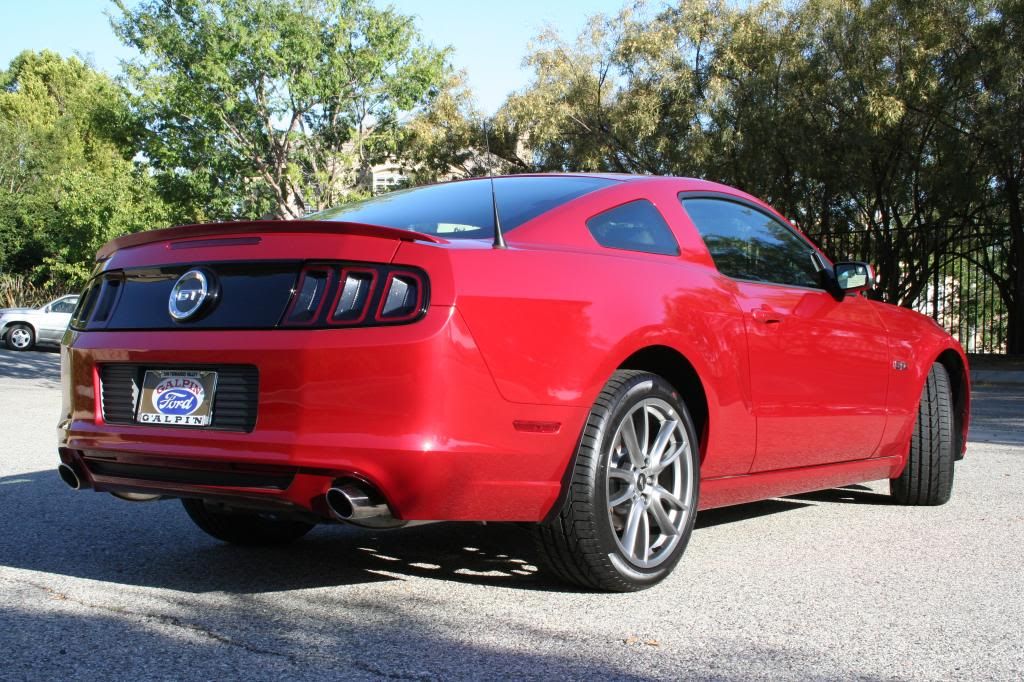
Here is my review on my ‘stock’ experience thus far…
When you look at this car you know it is a Mustang. And, it looks fantastic! The hood, grill, fascia, and fenders mold perfectly with the HID headlamps creating an aggressive appearance and attitude. Of course, the LED parking lights look totally ‘trick’ and tend to make all other motorists jealous. Seriously, they are so cool that you want to drive with the parking lights on all-the-time. Is that legal? The tough looking and functional heat extractors on the hood combined with the race-inspired front air-splitter also add to the overall persona. It doesn’t stop there. The rear LED tail lamps and rear black-out panel look awesome! The rear spoiler is also a nice touch. This is one great looking Mustang!
The Red Candy Metallic Tinted Clearcoat was not my first choice. However, over the past couple weeks this color has really grown on me. The Red Candy Metallic, combined with the dark Brembo package wheels looks really sharp. I get a lot of compliments from folks that stop to talk to me at the local gas stations and parking lots which is always welcome.
If there are any issues with the exterior, my only complaint would be regarding the big, solid side-view mirrors. They are in the worst possible location for ‘spirited’ driving. The mirrors completely block-out the view of any approaching corner Apex. Basically, I have to ‘guess’ where to place the car while driving though a corner. It sucks. I would have preferred that Ford allowed the side door window to extend all the way to the front A-pillar, then design a mirror with ‘arms’ that attach to the door at another location creating a small window to help give me more visibility to help navigate through corners. But, I digress; overall, Ford really did a great job.
They really nailed the appearance of this Mustang, right on the money.
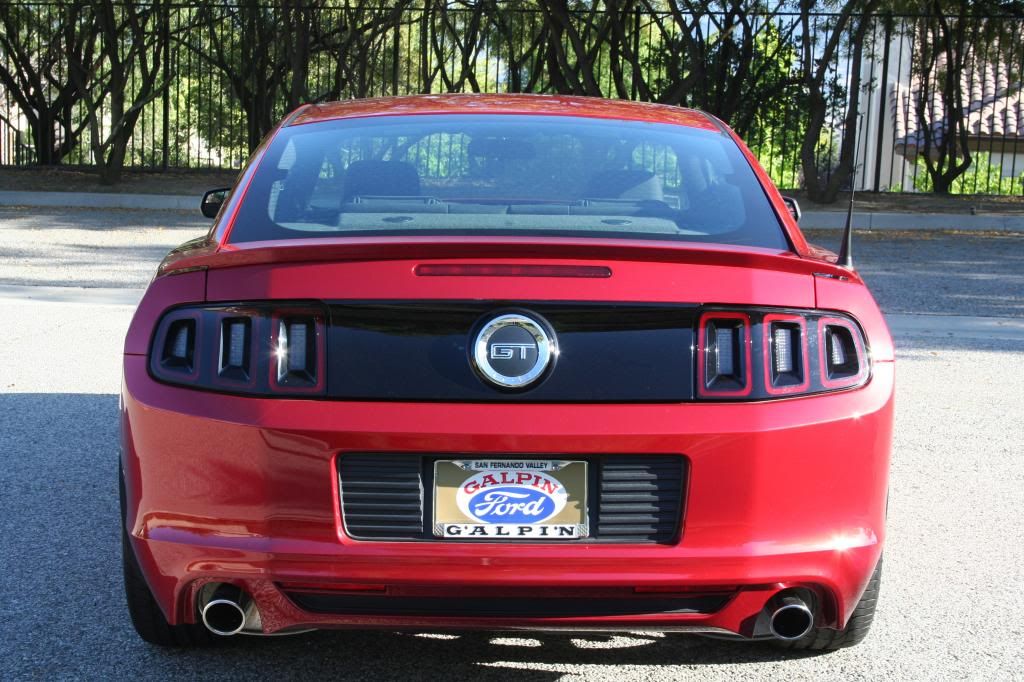
The interior. The Base 2013 Mustang interior is consistent with the previous S-197 designs which have a retro looking gauge cluster and dash layout. The overall design shares many similarities with Mustangs from the 60’s (with the exception of a full center console and electronic gear) and having owned a 1966 and a 1968 Mustang, I feel right at home sitting in the driver’s seat. Even though the gauges look great, the RPM, and especially the MPH intervals are placed too close together making them difficult to read at times with the long thick indicator needle blocking the view of the numbers. Do you feel the same? In addition, this is a performance car, where are my oil pressure and volt meter gauges?
The radio, a/c controls, handles, levers, and various switches are placed in smart locations for easy access and despite many magazine reviews, I find absolutely no problems with the ergonomics in the design.
The materials used throughout the interior are somewhat cheap to the touch and in appearance but, this is not an expensive car, so I shouldn’t expect too much. Moreover, the materials and interior quality is the same with all other cars in this category and price-range. I do like the fact that the dash pad and door panels have soft-touch material, in contrast to the hard plastic found elsewhere but, I wish they would have continued this theme throughout the rest of the interior. It would make the interior so much nicer!
The radio is an epic fail. The sound quality is very disappointing for a new car. In fact, it is terrible. I do hope some new speakers will improve the sound. It needs it. With the radio turned off, the cabin is relatively quiet and you can’t hear too much wind or road noise which is pretty impressive for a performance car in this price range. Perhaps it was deliberate since it gives you a better opportunity to listen to the beautiful sounds of the engine.
The manual front seats are comfortable and reasonably supportive. However, the front seat head restraints are annoying. They are positioned too far forward and bump the back of my head constantly. They are so bad, I removed them. I plan on making some custom restraints that will be more comfortable on a daily basis and will not push my head forward, or interfere with my helmet when I’m driving on the track. The rear fold-down seats are also soft, contured nicely, and comfortable (for smaller folks like me). I like the fact that the rear seat head restraints fold forward so they don’t disturb my rearward view while driving. Furthermore, the rear seat latch and release mechanism could use a better and sturdier design but, it does work.
The trunk compartment sports a small opening, however the amount of available space is good, deep, sufficient (especially with the fold-down rear seats), and better than many of the previous coupes I’ve owned. But, where is my spare tire? Automotive manufactures need to stop this crap! Put a spare tire in the car! Luckily, I haven’t had too many flat tires but, when I have, the damage is always too severe for a compressor, or a container of fix-a-flat to get me back on the road. My fingers will remain crossed.
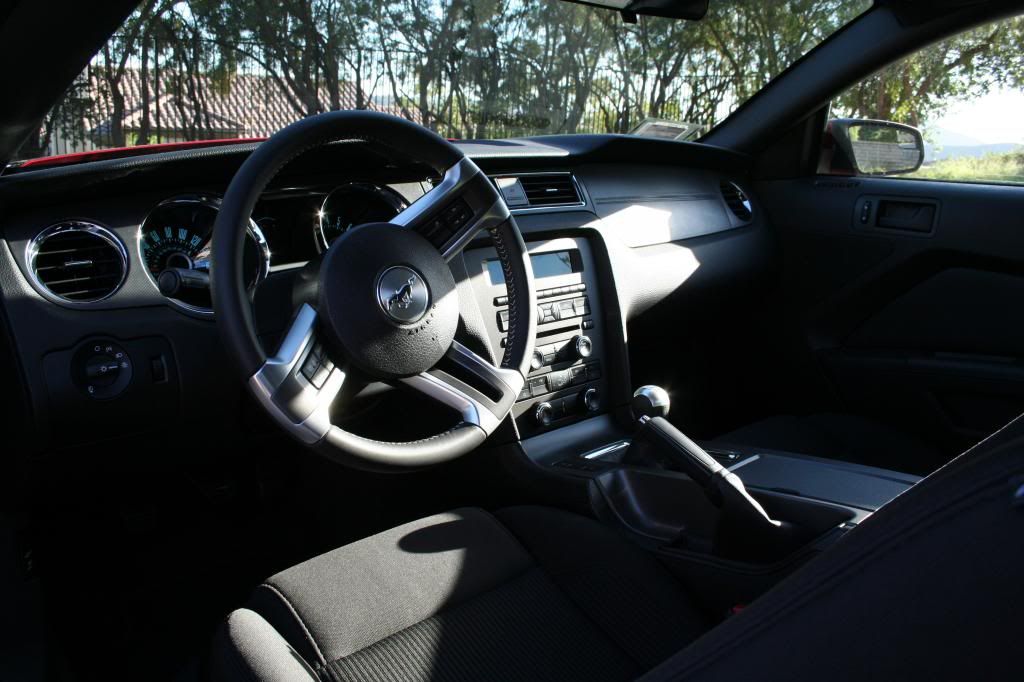
The Coyote 5.0 V8 engine is the center-piece and crown-jewel of this Mustang. The new 5.0 engine ‘makes’ the new Mustang GT. Without it, it wouldn’t be the same car. The new coyote 5.0 engine is strong, responds quickly, pulls hard, and loves to rev. This is the first American V8 that I have driven, that feels both European and American. It has all the low-end torque from the 60’s and 70’s muscle cars but, it also has the high-end horsepower of a true European sports car V8. It is a brilliant combination. However, despite the 5.0’s incredibly potent power output, I think the best feature of this engine is the 7,000 RPM redline and the fact that this V8 really enjoys the high RPM’s. You can’t buy a car equipped with a similar engine for less than $60K. That says something! This engine makes the Mustang GT driving experience the best it has ever been. Seriously!
One feature I don’t like about new engines is the TBW (Throttle-By-Wire) system because there is no physical connection between your foot and the throttle plate. I definitely prefer a traditional throttle-cable setup. The reason for this is because poor throttle response can ruin the driving experience of an outstanding engine and it is difficult to find good throttle response these days with a TBW setup. I driven and owned plenty of cars with poor throttle response, which in turn, killed the driving experience. There is nothing worse than pushing the accelerator pedal and having to wait for a response. I read several horror stories regarding the throttle response of the Coyote 5.0 but, I was pleasantly surprised to find a natural and timely throttle response to all my inputs in all conditions. I think Ford did a good job with the factory tuning.
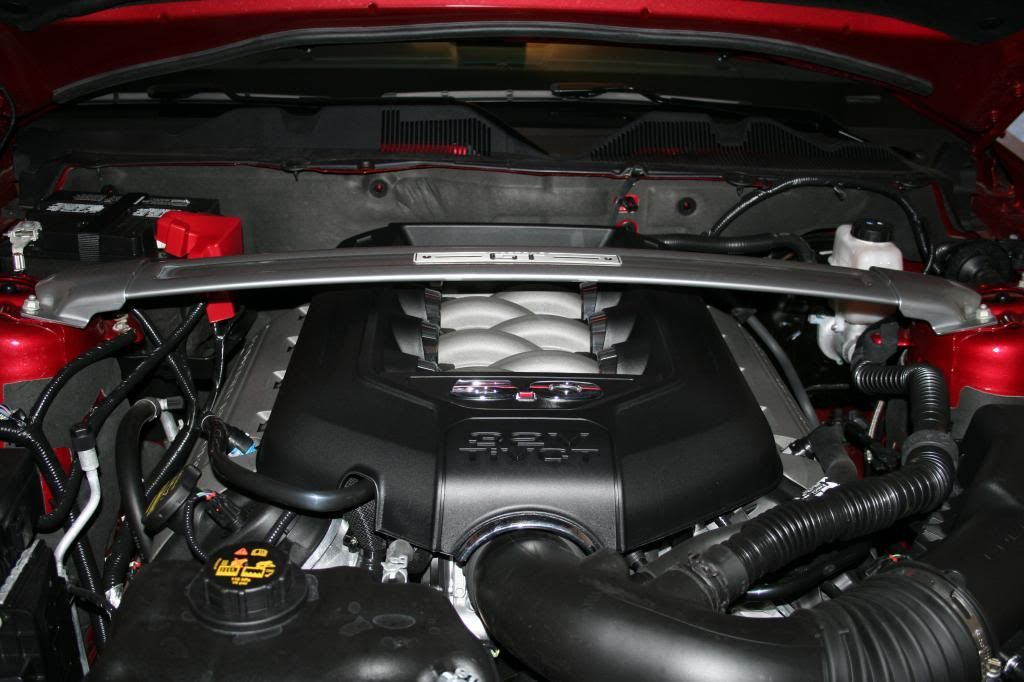
Though, let’s not go too far, of course, there is always room for improvement...somewhere. The sound quality, tone, and volume of the stock Mustang exhaust system does not do any justice to the fantastic 5.0 engine, the GT’s awesome performance, or the Mustang lineage. This should come as no surprise since pretty much every modern Mustang has a factory exhaust system that is understated and far too quiet for any true enthusiast, which is a shame because every V8 Mustang has the potential to be one of the best sounding cars on the road. Thank God for the aftermarket! LOL! I’m sure I’m not the first Mustang owner that has felt this way.
Continuing with my thoughts on ‘sound’, one thing that is really out of place on this car is the ridiculous sound pipe that feeds artificial engine noise into the cabin. I don’t get it. Ford creates one of the best V8’s available on the market today and yet, they need to feed artificial sound into the cabin? Insanity! I’ll be removing this pipe, plugging the holes, and enjoy the natural engine and exhaust sound from the driver’s seat.
The MT82 transmission feels much better than previous Ford transmissions and the internal gearing is well matched with the Coyote 5.0 engine. This transmission isn’t quite on par with the error-free operation and slick-shifting Japanese 6-speed transmissions I’ve experienced in other vehicles but, it is a huge improvement for the Mustang. The shifter engages gears smoothly and the gear throws are fairly short and direct which is better than some of the more vague shifters in competitor’s cars. I’m glad the shifter feels good because I find myself shifting a lot due to the MT82 transmissions short internal gearing combined with the optional factory 3.73 rear differential gears. Don’t get me wrong, I don’t mind shifting but, I have to admit that the factory 3.31’s might be the better choice for daily driving and are likely the better choice with this transmission. On the flip-side, the 3.73’s deliver immediate acceleration and response from every gear at virtually any speed, which I like. If in the future, I can find some more RPM, say another 500 RPM (like the Boss has), I think the 3.73’s will be a perfect match.
The clutch is easy to depress and engage, but not overly easy. I would describe the clutch engagement as a light to medium-light effort. Many of the new cars have clutches that are way too light which makes performance driving difficult and uncomfortable. I like the balance of this setup.
Industry wide, new car chassis’s seem to keep getting better year after year and this new Mustang is no exception. The chassis is good, strong, and reinforced properly. The Mustang absorbs all bumps, hits, and twists really, really well. The stock suspension is also impressive. There is a lot of grip and the Mustang stays firmly attached to the road on all surfaces and in all dry conditions. I have experienced a bit of bumpiness and wallowing from the rear end during some spirited driving which can be a confidence killer for a driver like me. I already plan on lowering the car so I’ll address this issue at that time. Basically, I’ll be looking to change the handling characteristics of the suspension to suit my preference which will increase my confidence while also improving the suspension geometry, transition speed, control, and overall grip so I can get the most performance from this car.
Many magazines have complained that the steering is too light and lacks any communication with the road. I think they either need to drive a 2013, or they are simply wrong. The steering response is nicely weighted to the speed of travel and the steering feedback is sharp and responsive to all inputs.
To be forthcoming, I’m honestly not a huge fan of Brembo brakes. I’ve had them as an OEM option on a couple previous cars and have come to realized that replacement brake pads are expensive and the brake pads tend to dust a lot which requires extra attention to keep the wheel finish clean and looking good. However, despite the minor disadvantages, the Brembo brakes perform as expected and the Brembo 4-piston calipers do look good. In truth, I purchased the Brembo package on my Mustang because I wanted the Wheels that came with the package. I think these 19 inch wheels look great on this car!
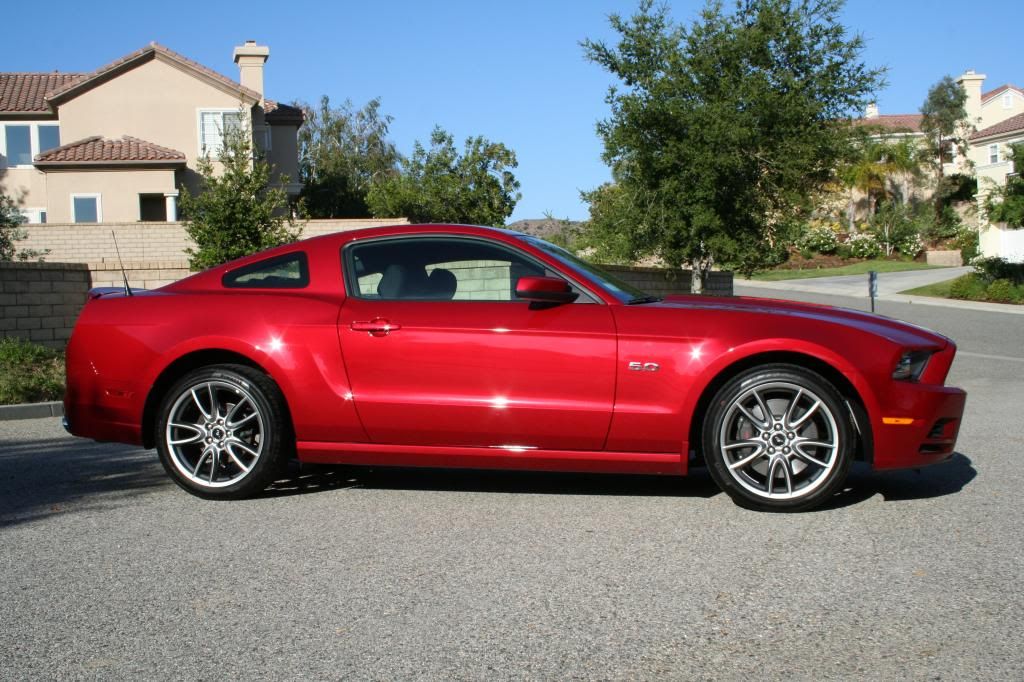
How does it all come together?
The Mustangs combination of great looks, comfortable interior, thoughtful ergonomics, performance capabilities and performance potential along with the overall driving experience make this a complete car. These attributes definitely sold me on this car. Personally, I can’t believe that the Mustang has come this far over the years. I have driven virtually every modern Mustang in both stock and modified forms and this is the first completely stock Mustang that is ready for the track straight from the dealer showroom. For the price, you can’t beat the value, especially when considering the performance. Which leads to this…Did I mention that the GT is fast? This car really hustles from a dead-stop and rewards you with a tremendous rush of power and immediate acceleration. It’s evil. The most common phrase I hear from my passengers is ‘whoaoaoaoa, holy cow, this thing is fast…or something to that effect’. Even on the highway, at speed, if you downshift, things get serious in a hurry but, for the most part, I just leave it in 6th gear and pass other motorists without incident. There really is no need to downshift. There is enough power everywhere in the RPM range. The acceleration is no joke!
Straight line acceleration isn’t the only thing this Mustang can do well. The stock chassis and suspension is more than capable and carving corners comes entirely naturally. When I say there is a ton of grip, there is a TON of grip. I expected a more lively experience while negotiating corners at high speeds but, the Mustang actually feels light and easily maneuvers through each corner without drama. The turn-in response and overall handling ability is very impressive for such a heavy car. I definitely was taken by surprise during my initial spirited drives at how well this car truly handles. As mentioned before the Brembo brakes perform as expected confidently slowing or stopping the car in a hurry and complete the package. I really like the results.
The Mustang GT’s extraordinary engine, chassis, suspension, and transmission are all well matched and perform far beyond expectation. I can’t wait to hit my local road-courses in my new GT.
The goal of my build is to tastefully upgrade the sound, appearance, drivetrain, and handling of my Mustang focusing on track performance but never forgetting that this is a STREET car and my daily driver.
If you are interested, please stay tuned…
Mike
My new ride is a 2013 Mustang GT Base Coupe with a 6-speed manual in Red Candy Metallic Tinted Clearcoat and black cloth interior. The only factory options are the Brembo package and 3.73 gears.

This is my fourth Mustang. I’ve previously owned an eye-catching 1966 289 Coupe, a perfect 1968 302 Coupe, and a super clean 1986 GT.
I must admit, it is great to be back driving a Mustang. And, it’s even more rewarding to once again, be driving a 5.0 V8 with a manual transmission.
The focus of this thread is to illustrate the path that I take to the upgrade, improve, and modify my new 2013 Mustang GT. I’ll include pictures and reviews of each modification I perform so that the information I share may benefit the community and perhaps help others in their quest to customize, or personalize their own Mustangs.
Let me begin.
I love cars. Over the years I’ve owned a ridiculous amount of cars of various makes and models both new and used. I enjoy the unique driving experience that each different type of car has to offer on and off the road. Due to my years of driving experience in so many cars, and the fact that I am an overly eccentric certified car enthusiast, I don’t hold any true brand loyalty to any manufacture. I simply try to buy the best car in the category I’m considering and at a price-range I can afford. This time around, it was the 2013 Ford Mustang GT. My new Mustang will serve as my regular daily-driver and weekend track-toy.
So why did I buy a new car? Ah, that’s easy. I missed driving a front engine, rear drive, 2+2 coupe with a V8, and a manual transmission. I love this combination of convenience, versatility, power, and fun. There are several cars that could serve my prescription but, even though the Challenger is a good looking car, my past has taught me not buy a Dodge product. You may be surprised but, even though I have a soft-spot for Chevy, each of new the Camaro SS’s I’ve driven over the past couple years left me thinking it feels big, bloated, heavy, and lazy. And it doesn’t stop there, the interior feels like you are sitting in a deep, bizarre, cheap, flimsy, Tupperware tub with strange futuristic cartoonish controls and poor outward visibility. The Chevrolet Camaro SS experience is frankly, disappointing and simply doesn’t measure up to the competition. As you can tell, I’m just not impressed with the new Camaro. Moreover the BMW M3 and Audi S5 are far too expensive and don’t have the raw performance I want, or expect from this type of platform. Furthermore, and most importantly, the European coupes just aren’t fun to drive.
In contrast, that wasn’t the way I felt after driving my first Coyote powered Mustang GT. The Mustang is comfortable, responsive, alive, and eager on the road. The Mustang is thoroughly enjoyable to drive. Plus, considering the competition, it is very affordable. In the end, you really can’t beat the value and performance of the Mustang GT. I was, and am, thoroughly impressed with the new Mustang. I know I’m going to enjoy this car.

Here is my review on my ‘stock’ experience thus far…
When you look at this car you know it is a Mustang. And, it looks fantastic! The hood, grill, fascia, and fenders mold perfectly with the HID headlamps creating an aggressive appearance and attitude. Of course, the LED parking lights look totally ‘trick’ and tend to make all other motorists jealous. Seriously, they are so cool that you want to drive with the parking lights on all-the-time. Is that legal? The tough looking and functional heat extractors on the hood combined with the race-inspired front air-splitter also add to the overall persona. It doesn’t stop there. The rear LED tail lamps and rear black-out panel look awesome! The rear spoiler is also a nice touch. This is one great looking Mustang!
The Red Candy Metallic Tinted Clearcoat was not my first choice. However, over the past couple weeks this color has really grown on me. The Red Candy Metallic, combined with the dark Brembo package wheels looks really sharp. I get a lot of compliments from folks that stop to talk to me at the local gas stations and parking lots which is always welcome.
If there are any issues with the exterior, my only complaint would be regarding the big, solid side-view mirrors. They are in the worst possible location for ‘spirited’ driving. The mirrors completely block-out the view of any approaching corner Apex. Basically, I have to ‘guess’ where to place the car while driving though a corner. It sucks. I would have preferred that Ford allowed the side door window to extend all the way to the front A-pillar, then design a mirror with ‘arms’ that attach to the door at another location creating a small window to help give me more visibility to help navigate through corners. But, I digress; overall, Ford really did a great job.
They really nailed the appearance of this Mustang, right on the money.

The interior. The Base 2013 Mustang interior is consistent with the previous S-197 designs which have a retro looking gauge cluster and dash layout. The overall design shares many similarities with Mustangs from the 60’s (with the exception of a full center console and electronic gear) and having owned a 1966 and a 1968 Mustang, I feel right at home sitting in the driver’s seat. Even though the gauges look great, the RPM, and especially the MPH intervals are placed too close together making them difficult to read at times with the long thick indicator needle blocking the view of the numbers. Do you feel the same? In addition, this is a performance car, where are my oil pressure and volt meter gauges?
The radio, a/c controls, handles, levers, and various switches are placed in smart locations for easy access and despite many magazine reviews, I find absolutely no problems with the ergonomics in the design.
The materials used throughout the interior are somewhat cheap to the touch and in appearance but, this is not an expensive car, so I shouldn’t expect too much. Moreover, the materials and interior quality is the same with all other cars in this category and price-range. I do like the fact that the dash pad and door panels have soft-touch material, in contrast to the hard plastic found elsewhere but, I wish they would have continued this theme throughout the rest of the interior. It would make the interior so much nicer!
The radio is an epic fail. The sound quality is very disappointing for a new car. In fact, it is terrible. I do hope some new speakers will improve the sound. It needs it. With the radio turned off, the cabin is relatively quiet and you can’t hear too much wind or road noise which is pretty impressive for a performance car in this price range. Perhaps it was deliberate since it gives you a better opportunity to listen to the beautiful sounds of the engine.
The manual front seats are comfortable and reasonably supportive. However, the front seat head restraints are annoying. They are positioned too far forward and bump the back of my head constantly. They are so bad, I removed them. I plan on making some custom restraints that will be more comfortable on a daily basis and will not push my head forward, or interfere with my helmet when I’m driving on the track. The rear fold-down seats are also soft, contured nicely, and comfortable (for smaller folks like me). I like the fact that the rear seat head restraints fold forward so they don’t disturb my rearward view while driving. Furthermore, the rear seat latch and release mechanism could use a better and sturdier design but, it does work.
The trunk compartment sports a small opening, however the amount of available space is good, deep, sufficient (especially with the fold-down rear seats), and better than many of the previous coupes I’ve owned. But, where is my spare tire? Automotive manufactures need to stop this crap! Put a spare tire in the car! Luckily, I haven’t had too many flat tires but, when I have, the damage is always too severe for a compressor, or a container of fix-a-flat to get me back on the road. My fingers will remain crossed.

The Coyote 5.0 V8 engine is the center-piece and crown-jewel of this Mustang. The new 5.0 engine ‘makes’ the new Mustang GT. Without it, it wouldn’t be the same car. The new coyote 5.0 engine is strong, responds quickly, pulls hard, and loves to rev. This is the first American V8 that I have driven, that feels both European and American. It has all the low-end torque from the 60’s and 70’s muscle cars but, it also has the high-end horsepower of a true European sports car V8. It is a brilliant combination. However, despite the 5.0’s incredibly potent power output, I think the best feature of this engine is the 7,000 RPM redline and the fact that this V8 really enjoys the high RPM’s. You can’t buy a car equipped with a similar engine for less than $60K. That says something! This engine makes the Mustang GT driving experience the best it has ever been. Seriously!
One feature I don’t like about new engines is the TBW (Throttle-By-Wire) system because there is no physical connection between your foot and the throttle plate. I definitely prefer a traditional throttle-cable setup. The reason for this is because poor throttle response can ruin the driving experience of an outstanding engine and it is difficult to find good throttle response these days with a TBW setup. I driven and owned plenty of cars with poor throttle response, which in turn, killed the driving experience. There is nothing worse than pushing the accelerator pedal and having to wait for a response. I read several horror stories regarding the throttle response of the Coyote 5.0 but, I was pleasantly surprised to find a natural and timely throttle response to all my inputs in all conditions. I think Ford did a good job with the factory tuning.

Though, let’s not go too far, of course, there is always room for improvement...somewhere. The sound quality, tone, and volume of the stock Mustang exhaust system does not do any justice to the fantastic 5.0 engine, the GT’s awesome performance, or the Mustang lineage. This should come as no surprise since pretty much every modern Mustang has a factory exhaust system that is understated and far too quiet for any true enthusiast, which is a shame because every V8 Mustang has the potential to be one of the best sounding cars on the road. Thank God for the aftermarket! LOL! I’m sure I’m not the first Mustang owner that has felt this way.
Continuing with my thoughts on ‘sound’, one thing that is really out of place on this car is the ridiculous sound pipe that feeds artificial engine noise into the cabin. I don’t get it. Ford creates one of the best V8’s available on the market today and yet, they need to feed artificial sound into the cabin? Insanity! I’ll be removing this pipe, plugging the holes, and enjoy the natural engine and exhaust sound from the driver’s seat.
The MT82 transmission feels much better than previous Ford transmissions and the internal gearing is well matched with the Coyote 5.0 engine. This transmission isn’t quite on par with the error-free operation and slick-shifting Japanese 6-speed transmissions I’ve experienced in other vehicles but, it is a huge improvement for the Mustang. The shifter engages gears smoothly and the gear throws are fairly short and direct which is better than some of the more vague shifters in competitor’s cars. I’m glad the shifter feels good because I find myself shifting a lot due to the MT82 transmissions short internal gearing combined with the optional factory 3.73 rear differential gears. Don’t get me wrong, I don’t mind shifting but, I have to admit that the factory 3.31’s might be the better choice for daily driving and are likely the better choice with this transmission. On the flip-side, the 3.73’s deliver immediate acceleration and response from every gear at virtually any speed, which I like. If in the future, I can find some more RPM, say another 500 RPM (like the Boss has), I think the 3.73’s will be a perfect match.
The clutch is easy to depress and engage, but not overly easy. I would describe the clutch engagement as a light to medium-light effort. Many of the new cars have clutches that are way too light which makes performance driving difficult and uncomfortable. I like the balance of this setup.
Industry wide, new car chassis’s seem to keep getting better year after year and this new Mustang is no exception. The chassis is good, strong, and reinforced properly. The Mustang absorbs all bumps, hits, and twists really, really well. The stock suspension is also impressive. There is a lot of grip and the Mustang stays firmly attached to the road on all surfaces and in all dry conditions. I have experienced a bit of bumpiness and wallowing from the rear end during some spirited driving which can be a confidence killer for a driver like me. I already plan on lowering the car so I’ll address this issue at that time. Basically, I’ll be looking to change the handling characteristics of the suspension to suit my preference which will increase my confidence while also improving the suspension geometry, transition speed, control, and overall grip so I can get the most performance from this car.
Many magazines have complained that the steering is too light and lacks any communication with the road. I think they either need to drive a 2013, or they are simply wrong. The steering response is nicely weighted to the speed of travel and the steering feedback is sharp and responsive to all inputs.
To be forthcoming, I’m honestly not a huge fan of Brembo brakes. I’ve had them as an OEM option on a couple previous cars and have come to realized that replacement brake pads are expensive and the brake pads tend to dust a lot which requires extra attention to keep the wheel finish clean and looking good. However, despite the minor disadvantages, the Brembo brakes perform as expected and the Brembo 4-piston calipers do look good. In truth, I purchased the Brembo package on my Mustang because I wanted the Wheels that came with the package. I think these 19 inch wheels look great on this car!

How does it all come together?
The Mustangs combination of great looks, comfortable interior, thoughtful ergonomics, performance capabilities and performance potential along with the overall driving experience make this a complete car. These attributes definitely sold me on this car. Personally, I can’t believe that the Mustang has come this far over the years. I have driven virtually every modern Mustang in both stock and modified forms and this is the first completely stock Mustang that is ready for the track straight from the dealer showroom. For the price, you can’t beat the value, especially when considering the performance. Which leads to this…Did I mention that the GT is fast? This car really hustles from a dead-stop and rewards you with a tremendous rush of power and immediate acceleration. It’s evil. The most common phrase I hear from my passengers is ‘whoaoaoaoa, holy cow, this thing is fast…or something to that effect’. Even on the highway, at speed, if you downshift, things get serious in a hurry but, for the most part, I just leave it in 6th gear and pass other motorists without incident. There really is no need to downshift. There is enough power everywhere in the RPM range. The acceleration is no joke!
Straight line acceleration isn’t the only thing this Mustang can do well. The stock chassis and suspension is more than capable and carving corners comes entirely naturally. When I say there is a ton of grip, there is a TON of grip. I expected a more lively experience while negotiating corners at high speeds but, the Mustang actually feels light and easily maneuvers through each corner without drama. The turn-in response and overall handling ability is very impressive for such a heavy car. I definitely was taken by surprise during my initial spirited drives at how well this car truly handles. As mentioned before the Brembo brakes perform as expected confidently slowing or stopping the car in a hurry and complete the package. I really like the results.
The Mustang GT’s extraordinary engine, chassis, suspension, and transmission are all well matched and perform far beyond expectation. I can’t wait to hit my local road-courses in my new GT.
The goal of my build is to tastefully upgrade the sound, appearance, drivetrain, and handling of my Mustang focusing on track performance but never forgetting that this is a STREET car and my daily driver.
If you are interested, please stay tuned…
Mike











